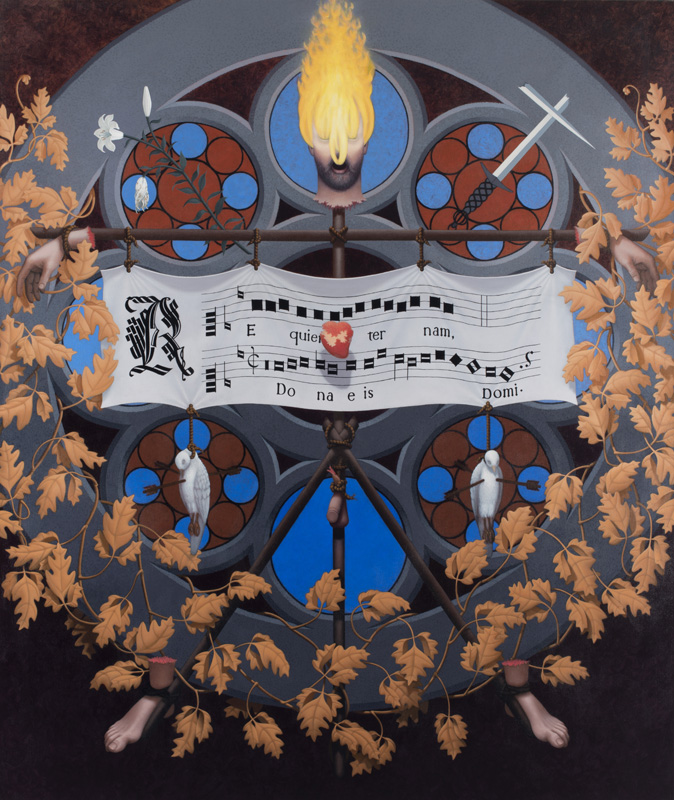
 |
| Requiem 1997, acrylic on canvas 78 x 66 in. |
Requiem |
In general terms a requiem is an act or token of remembrance. In musical terms it refers to a composition performed in a religious ceremony to honor and pray for the dead. Throughout the history of music there have been innumerable musical compositions written for the ceremony. Given the solemnity of the occasion they are typically serious and somber in character and tone. Because I have listened to and enjoyed musical requiems over the years I thought it would be interesting to create a visual representation of one. The composition of Requiem is generally symmetrical and dominated by three main elements - a large stylized rose window, a scarecrow form, and a leaf-covered vine. The rose window is constructed of ten circular sections – a large outer section, a smaller inner one, and eight equally sized sections, or inner windows, sandwiched between the other two. This construction pattern can be seen restated as a de facto stained glass design in four of the inner windows. The other four windows in the group provide a view to a transcendent blue space beyond. It is interesting to note that these eight inner windows also function as framing devices for different elements. By framing I mean placing two elements in relation to one another so as to accentuate, or put greater focus on, the one in front. Primary among the placements is the burning head framed against the blue of the upper window. The coloration and activity of the burning head stands out against the empty blue background thereby accentuating both elements. Symbolically I see the burning head as representing change, transformation and purification. The window to the left of the upper window frames a lily with three flowers – one unopened, one in full bloom, and the last one dying. Each of these is symbolic of the three stages of life – purity and innocence of youth, beauty and fullness of adulthood, and the decline and withering of old age. It is also interesting to note that the dying flower, which also symbolizes death and transcendence, is framed in a smaller blue window. On the opposite side, framed in the upper right window, is a broken sword. It represents the end of life's battle. Below, framed in the lower left and lower right windows, is a dead dove. Each bird is depicted hanging from a rope and pierced by three arrows. They symbolically reiterate the theme of death and the end of the pain and violence of life. Lastly the lower window frames a severed penis. This element serves as a harsh reminder of the loss of fertility at life's ends. Overall the scarecrow form is a stark representation of the dead. It is a fractured body constructed from wooden poles bound together by ropes with various body parts and a white cloth banner attached. This combination of poles and body parts suggest a human figure without having a complete figure rendered. At the same time it references the pain, suffering, and dissolution of life. The cloth banner, which hangs down from the horizontal pole of the scarecrow, is located in the middle of the composition. Positioned in this way it becomes the main focal point of the painting. Rendered in black on the banner's white background is the beginning musical notation from Tomas Luis de Victoria's Officium Defunctorum, a musical setting for the Office of the Dead. Translated the latin text reads, "Eternal rest grant unto them, O Lord". I decided to use Victoria's composition because it is one of my favorite pieces of Renaissance choral music and because I wanted to directly reference music as the core inspiration for the painting. Lastly, I placed a stylized heart floating above the banner at the center of the composition. I think of it as the "heart" of the painting with its reference to loss, love, and life. The leaf-covered vine is depicted growing around the bottom and sides of both the rose window and the scarecrow. It is rendered in an orange-brown color to reference dying leaves and the last stages of life. The vine is a symbol for entanglement, or more specifically that we are all inextricably connected to nature and the world. Formally the leaf-covered vine helps unify the composition while also providing an organic element that complements the geometry of the rose window and the scarecrow. - Brian Mains, February 2020 |